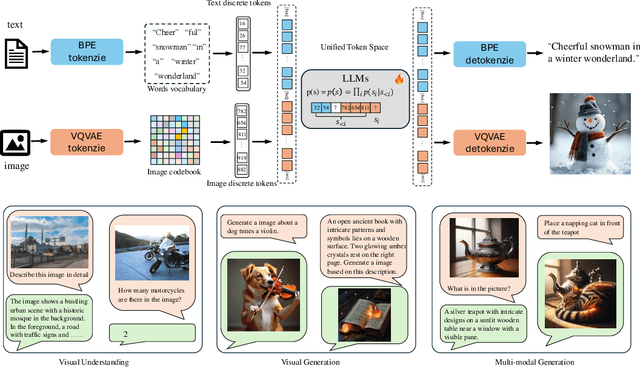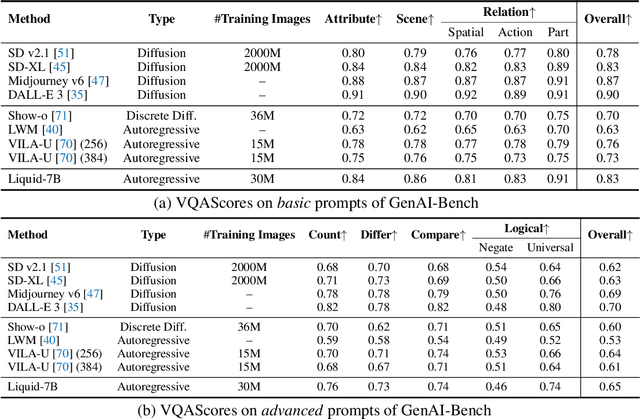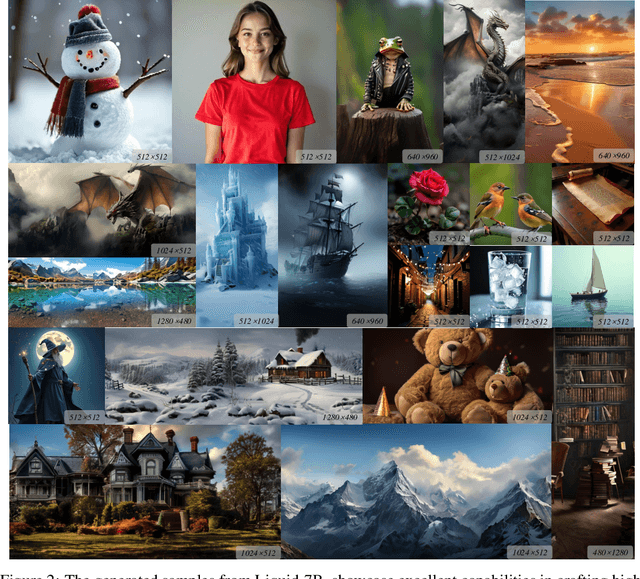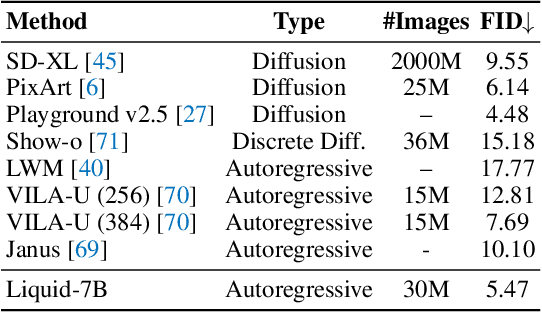Yuliang Liu
Privacy-Preserving Biometric Verification with Handwritten Random Digit String
Mar 17, 2025Abstract:Handwriting verification has stood as a steadfast identity authentication method for decades. However, this technique risks potential privacy breaches due to the inclusion of personal information in handwritten biometrics such as signatures. To address this concern, we propose using the Random Digit String (RDS) for privacy-preserving handwriting verification. This approach allows users to authenticate themselves by writing an arbitrary digit sequence, effectively ensuring privacy protection. To evaluate the effectiveness of RDS, we construct a new HRDS4BV dataset composed of online naturally handwritten RDS. Unlike conventional handwriting, RDS encompasses unconstrained and variable content, posing significant challenges for modeling consistent personal writing style. To surmount this, we propose the Pattern Attentive VErification Network (PAVENet), along with a Discriminative Pattern Mining (DPM) module. DPM adaptively enhances the recognition of consistent and discriminative writing patterns, thus refining handwriting style representation. Through comprehensive evaluations, we scrutinize the applicability of online RDS verification and showcase a pronounced outperformance of our model over existing methods. Furthermore, we discover a noteworthy forgery phenomenon that deviates from prior findings and discuss its positive impact in countering malicious impostor attacks. Substantially, our work underscores the feasibility of privacy-preserving biometric verification and propels the prospects of its broader acceptance and application.
OmniParser V2: Structured-Points-of-Thought for Unified Visual Text Parsing and Its Generality to Multimodal Large Language Models
Feb 22, 2025Abstract:Visually-situated text parsing (VsTP) has recently seen notable advancements, driven by the growing demand for automated document understanding and the emergence of large language models capable of processing document-based questions. While various methods have been proposed to tackle the complexities of VsTP, existing solutions often rely on task-specific architectures and objectives for individual tasks. This leads to modal isolation and complex workflows due to the diversified targets and heterogeneous schemas. In this paper, we introduce OmniParser V2, a universal model that unifies VsTP typical tasks, including text spotting, key information extraction, table recognition, and layout analysis, into a unified framework. Central to our approach is the proposed Structured-Points-of-Thought (SPOT) prompting schemas, which improves model performance across diverse scenarios by leveraging a unified encoder-decoder architecture, objective, and input\&output representation. SPOT eliminates the need for task-specific architectures and loss functions, significantly simplifying the processing pipeline. Our extensive evaluations across four tasks on eight different datasets show that OmniParser V2 achieves state-of-the-art or competitive results in VsTP. Additionally, we explore the integration of SPOT within a multimodal large language model structure, further enhancing text localization and recognition capabilities, thereby confirming the generality of SPOT prompting technique. The code is available at \href{https://github.com/AlibabaResearch/AdvancedLiterateMachinery}{AdvancedLiterateMachinery}.
AdaptiveStep: Automatically Dividing Reasoning Step through Model Confidence
Feb 19, 2025Abstract:Current approaches for training Process Reward Models (PRMs) often involve breaking down responses into multiple reasoning steps using rule-based techniques, such as using predefined placeholder tokens or setting the reasoning step's length into a fixed size. These approaches overlook the fact that specific words do not typically mark true decision points in a text. To address this, we propose AdaptiveStep, a method that divides reasoning steps based on the model's confidence in predicting the next word. This division method provides more decision-making information at each step, enhancing downstream tasks, such as reward model learning. Moreover, our method does not require manual annotation. We demonstrate its effectiveness through experiments with AdaptiveStep-trained PRMs in mathematical reasoning and code generation tasks. Experimental results indicate that the outcome PRM achieves state-of-the-art Best-of-N performance, surpassing greedy search strategy with token-level value-guided decoding, while also reducing construction costs by over 30% compared to existing open-source PRMs. In addition, we provide a thorough analysis and case study on the PRM's performance, transferability, and generalization capabilities.
OCRBench v2: An Improved Benchmark for Evaluating Large Multimodal Models on Visual Text Localization and Reasoning
Dec 31, 2024



Abstract:Scoring the Optical Character Recognition (OCR) capabilities of Large Multimodal Models (LMMs) has witnessed growing interest recently. Existing benchmarks have highlighted the impressive performance of LMMs in text recognition; however, their abilities on certain challenging tasks, such as text localization, handwritten content extraction, and logical reasoning, remain underexplored. To bridge this gap, we introduce OCRBench v2, a large-scale bilingual text-centric benchmark with currently the most comprehensive set of tasks (4x more tasks than the previous multi-scene benchmark OCRBench), the widest coverage of scenarios (31 diverse scenarios including street scene, receipt, formula, diagram, and so on), and thorough evaluation metrics, with a total of 10,000 human-verified question-answering pairs and a high proportion of difficult samples. After carefully benchmarking state-of-the-art LMMs on OCRBench v2, we find that 20 out of 22 LMMs score below 50 (100 in total) and suffer from five-type limitations, including less frequently encountered text recognition, fine-grained perception, layout perception, complex element parsing, and logical reasoning. The benchmark and evaluation scripts are available at https://github.com/Yuliang-liu/MultimodalOCR.
Liquid: Language Models are Scalable Multi-modal Generators
Dec 05, 2024



Abstract:We present Liquid, an auto-regressive generation paradigm that seamlessly integrates visual comprehension and generation by tokenizing images into discrete codes and learning these code embeddings alongside text tokens within a shared feature space for both vision and language. Unlike previous multimodal large language model (MLLM), Liquid achieves this integration using a single large language model (LLM), eliminating the need for external pretrained visual embeddings such as CLIP. For the first time, Liquid uncovers a scaling law that performance drop unavoidably brought by the unified training of visual and language tasks diminishes as the model size increases. Furthermore, the unified token space enables visual generation and comprehension tasks to mutually enhance each other, effectively removing the typical interference seen in earlier models. We show that existing LLMs can serve as strong foundations for Liquid, saving 100x in training costs while outperforming Chameleon in multimodal capabilities and maintaining language performance comparable to mainstream LLMs like LLAMA2. Liquid also outperforms models like SD v2.1 and SD-XL (FID of 5.47 on MJHQ-30K), excelling in both vision-language and text-only tasks. This work demonstrates that LLMs such as LLAMA3.2 and GEMMA2 are powerful multimodal generators, offering a scalable solution for enhancing both vision-language understanding and generation. The code and models will be released.
CC-OCR: A Comprehensive and Challenging OCR Benchmark for Evaluating Large Multimodal Models in Literacy
Dec 03, 2024Abstract:Large Multimodal Models (LMMs) have demonstrated impressive performance on recognizing document images with natural language instructions. However, it remains unclear to what extent capabilities in literacy with rich structure and fine-grained visual challenges. The current landscape lacks a comprehensive benchmark to effectively measure the literate capabilities of LMMs. Existing benchmarks are often limited by narrow scenarios and specified tasks. To this end, we introduce CC-OCR, a comprehensive benchmark that possess a diverse range of scenarios, tasks, and challenges. CC-OCR comprises four OCR-centric tracks: multi-scene text reading, multilingual text reading, document parsing, and key information extraction. It includes 39 subsets with 7,058 full annotated images, of which 41% are sourced from real applications, being released for the first time. Furthermore, we evaluate nine prominent LMMs and reveal both the strengths and weaknesses of these models, particularly in text grounding, multi-orientation, and hallucination of repetition. CC-OCR aims to comprehensively evaluate the capabilities of LMMs on OCR-centered tasks, driving advancement in LMMs.
R-CoT: Reverse Chain-of-Thought Problem Generation for Geometric Reasoning in Large Multimodal Models
Oct 23, 2024Abstract:Existing Large Multimodal Models (LMMs) struggle with mathematical geometric reasoning due to a lack of high-quality image-text paired data. Current geometric data generation approaches, which apply preset templates to generate geometric data or use Large Language Models (LLMs) to rephrase questions and answers (Q&A), unavoidably limit data accuracy and diversity. To synthesize higher-quality data, we propose a two-stage Reverse Chain-of-Thought (R-CoT) geometry problem generation pipeline. First, we introduce GeoChain to produce high-fidelity geometric images and corresponding descriptions highlighting relations among geometric elements. We then design a Reverse A&Q method that reasons step-by-step based on the descriptions and generates questions in reverse from the reasoning results. Experiments demonstrate that the proposed method brings significant and consistent improvements on multiple LMM baselines, achieving new performance records in the 2B, 7B, and 8B settings. Notably, R-CoT-8B significantly outperforms previous state-of-the-art open-source mathematical models by 16.6% on MathVista and 9.2% on GeoQA, while also surpassing the closed-source model GPT-4o by an average of 13% across both datasets. The code is available at https://github.com/dle666/R-CoT.
PDF-WuKong: A Large Multimodal Model for Efficient Long PDF Reading with End-to-End Sparse Sampling
Oct 08, 2024Abstract:Document understanding is a challenging task to process and comprehend large amounts of textual and visual information. Recent advances in Large Language Models (LLMs) have significantly improved the performance of this task. However, existing methods typically focus on either plain text or a limited number of document images, struggling to handle long PDF documents with interleaved text and images, especially in academic papers. In this paper, we introduce PDF-WuKong, a multimodal large language model (MLLM) which is designed to enhance multimodal question-answering (QA) for long PDF documents. PDF-WuKong incorporates a sparse sampler that operates on both text and image representations, significantly improving the efficiency and capability of the MLLM. The sparse sampler is integrated with the MLLM's image encoder and selects the paragraphs or diagrams most pertinent to user queries for processing by the language model. To effectively train and evaluate our model, we construct PaperPDF, a dataset consisting of a broad collection of academic papers sourced from arXiv, multiple strategies are proposed to generate automatically 1M QA pairs along with their corresponding evidence sources. Experimental results demonstrate the superiority and high efficiency of our approach over other models on the task of long multimodal PDF understanding, surpassing proprietary products by an average of 8.6% on F1. Our code and dataset will be released at https://github.com/yh-hust/PDF-Wukong.
LongRecipe: Recipe for Efficient Long Context Generalization in Large Language Models
Sep 04, 2024Abstract:Large language models (LLMs) face significant challenges in handling long-context tasks because of their limited effective context window size during pretraining, which restricts their ability to generalize over extended sequences. Meanwhile, extending the context window in LLMs through post-pretraining is highly resource-intensive. To address this, we introduce LongRecipe, an efficient training strategy for extending the context window of LLMs, including impactful token analysis, position index transformation, and training optimization strategies. It simulates long-sequence inputs while maintaining training efficiency and significantly improves the model's understanding of long-range dependencies. Experiments on three types of LLMs show that LongRecipe can utilize long sequences while requiring only 30% of the target context window size, and reduces computational training resource over 85% compared to full sequence training. Furthermore, LongRecipe also preserves the original LLM's capabilities in general tasks. Ultimately, we can extend the effective context window of open-source LLMs from 8k to 128k, achieving performance close to GPT-4 with just one day of dedicated training using a single GPU with 80G memory. Our code is released at https://github.com/zhiyuanhubj/LongRecipe.
Mini-Monkey: Multi-Scale Adaptive Cropping for Multimodal Large Language Models
Aug 09, 2024



Abstract:Recently, there has been significant interest in enhancing the capability of multimodal large language models (MLLMs) to process high-resolution images. Most existing methods focus on adopting a cropping strategy to improve the ability of multimodal large language models to understand image details. However, this cropping operation inevitably causes the segmentation of objects and connected areas, which impairs the MLLM's ability to recognize small or irregularly shaped objects or text. This issue is particularly evident in lightweight MLLMs. Addressing this issue, we propose Mini-Monkey, a lightweight MLLM that incorporates a plug-and-play method called multi-scale adaptive crop strategy (MSAC). Mini-Monkey adaptively generates multi-scale representations, allowing it to select non-segmented objects from various scales. To mitigate the computational overhead introduced by MSAC, we propose a Scale Compression Mechanism (SCM), which effectively compresses image tokens. Mini-Monkey achieves state-of-the-art performance among 2B-parameter MLLMs. It not only demonstrates leading performance on a variety of general multimodal understanding tasks but also shows consistent improvements in document understanding capabilities. On the OCRBench, Mini-Monkey achieves a score of 802, outperforming 8B-parameter state-of-the-art model InternVL2-8B. Besides, our model and training strategy are very efficient, which can be trained with only eight RTX 3090. The code is available at https://github.com/Yuliang-Liu/Monkey.
 Add to Chrome
Add to Chrome Add to Firefox
Add to Firefox Add to Edge
Add to Edge